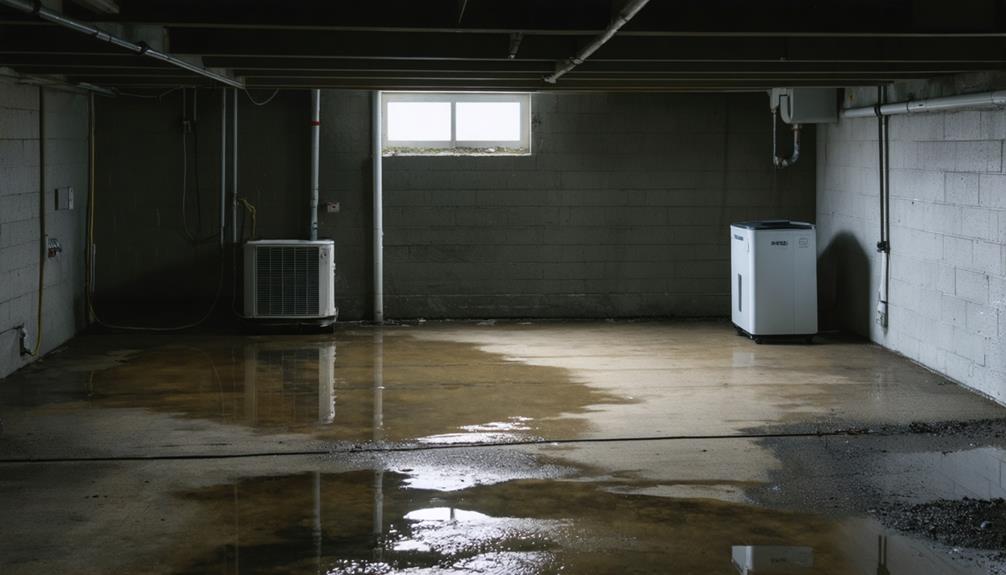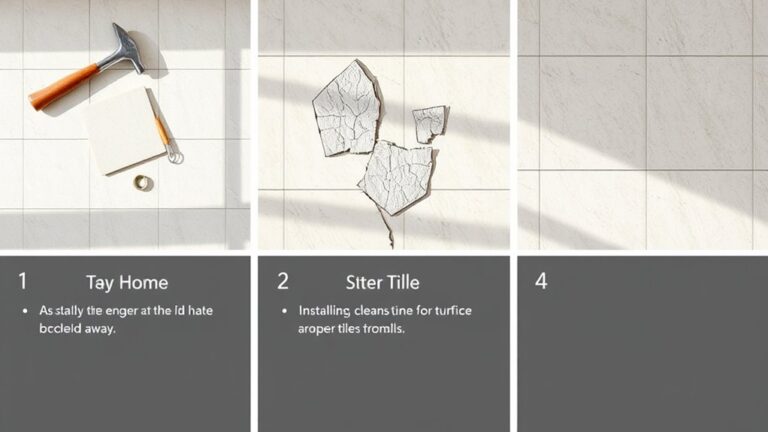Dealing with moisture in basement concrete floors is essential to prevent mold growth and health risks. First, assess moisture levels by inspecting for dark spots or musty odors, which indicate water issues. Use penetrating sealers and install vapor barriers before flooring to combat moisture. Maintain drainage systems like sump pumps regularly, and keep humidity below 60% with dehumidifiers to improve air quality. Also, check for cracks or joints that allow air leakage and moisture entry. With these strategies, you can effectively manage moisture levels and protect your basement environment. There's more to explore about practical solutions for long-term protection.
Health Risks of Basement Moisture
When dealing with moisture in your basement, it is important to understand the health risks associated with damp environments. Prolonged exposure to moisture can lead to the growth of mold and mildew, which are notorious for triggering respiratory issues and allergic reactions, especially in sensitive individuals. High humidity levels not only exacerbate these conditions but also degrade air quality, increasing the likelihood of mold proliferation.
If you notice musty odors in your basement, it is a clear sign of poor air quality. Such environments can contribute to headaches, fatigue, and symptoms of chemical sensitivity, making it necessary to address moisture issues promptly. Beyond immediate health effects, moisture can lead to structural deterioration in your home. As materials break down, they may release volatile organic compounds (VOCs) into the air, posing additional health risks that can affect everyone in your household.
Ignoring basement moisture can escalate these health risks, particularly if you plan to finish the space. Improper sealing and treatment can trap moisture, creating a breeding ground for mold in newly created living areas. It is crucial to recognize that the health implications of basement moisture extend far beyond simple discomfort; they can seriously impact your overall well-being. Understanding these risks empowers you to take action before they become more severe, ensuring a safe, healthy living environment free from the dangers of excess moisture.
Identifying Moisture Sources
Understanding the health risks of moisture in your basement sets the stage for identifying its sources. First, you need to assess the moisture level in your space. Excess moisture can often stem from groundwater infiltration, particularly if the ground around your home has poor drainage or high soil moisture levels. Look for signs of water coming from below, such as dark or wet spots on the concrete.
Condensation is another common culprit of basement moisture. This occurs when warm, moist air meets the cooler surface of your concrete floor, causing droplets to form. To distinguish between these sources, consider conducting a Visqueen test. Tape a plastic sheet to the floor; if you find droplets underneath, moisture is migrating from below. If the droplets are on top, it's likely condensation.
Persistent musty odors are also a strong indicator of moisture problems, often signaling mold or mildew growth. Regular monitoring of humidity levels in your basement is crucial. Use a hygrometer to track the moisture levels and conduct visual inspections for any dampness or mold.
If you suspect a drainage issue, examine the grading around your foundation and verify downspouts direct water away effectively. By identifying the sources of moisture, you can take proactive steps to mitigate the risks and maintain a healthier basement environment. Addressing these issues early can prevent more significant problems down the line.
Moisture Movement Mechanisms
Moisture movement in basement concrete floors is driven by several mechanisms that can greatly impact the integrity of your space. One primary mechanism is capillary suction, where water is drawn up through the concrete due to surface tension and adhesion. This process can lead to significant moisture levels, especially in areas with high groundwater or when your drainage system is inadequate.
Another vital factor is vapor diffusion, which occurs when water vapor migrates from areas of higher concentration to lower concentration. This is often exacerbated by temperature differentials; warm air can hold more moisture than cooler air, leading to condensation within your basement.
Air leakage through cracks and joints in the concrete allows humid air to infiltrate your basement, adding to the high moisture issues. These imperfections are common in many concrete slabs and can create pathways for moisture movement that you might overlook.
Additionally, hydrostatic pressure plays a significant role in moisture intrusion. When groundwater levels rise, this pressure can force moisture through the concrete slab, especially in regions with poor drainage or high water tables.
The soil type around your home also influences moisture movement. Finer soils like clay hold moisture more effectively than coarser soils such as gravel or sand, leading to increased capillary rise. Understanding these mechanisms is essential for tackling moisture issues effectively in your basement.
Effective Moisture Solutions
Numerous effective moisture solutions can help you combat the challenges posed by damp basement concrete floors. By implementing a combination of strategies, you can considerably reduce excessive moisture and protect your living space.
Firstly, consider using penetrating sealers on your concrete flooring. These sealers provide long-term resistance against moisture intrusion and staining. Additionally, installing vapor barriers before laying any flooring materials is vital, as they mitigate moisture-related issues and preserve the integrity of your floors.
Regular maintenance of drainage systems, including sump pumps and weep holes, is essential. This helps prevent water accumulation and effectively manages groundwater levels. Don't forget to conduct moisture testing, such as the Visqueen test, to determine whether dampness originates from below or is due to condensation. This information will guide your choice of solutions.
Proper ventilation strategies are equally important. Using dehumidifiers and fans can considerably reduce humidity levels in your basement, resulting in improved basement air quality. Below is a table summarizing these effective moisture solutions:
| Solution Type | Purpose | Key Component |
|---|---|---|
| Penetrating Sealers | Resist moisture intrusion & staining | Concrete |
| Drainage Systems | Prevent water accumulation | Sump Pump, Weep Holes |
| Ventilation | Reduce humidity & improve air quality | Dehumidifiers, Fans |
Long-Term Maintenance Strategies
While maintaining a dry and healthy basement might seem challenging, implementing long-term maintenance strategies can greatly reduce future moisture problems. Start by regularly inspecting your drainage systems and sump pump. Confirming they function properly can prevent water accumulation and long-term moisture issues in your basement concrete floors.
Incorporate dehumidifiers into your routine to keep indoor humidity levels below 60%. This helps mitigate moisture-related problems and reduces the risk of mold growth. Additionally, make it a habit to check your vapor barriers and sealants periodically; damaged barriers can allow moisture vapor to penetrate, compromising your concrete's integrity.
Proper site grading is essential. Verify that gutters and downspouts direct water away from your foundation to prevent groundwater infiltration, which can lead to dampness beneath your concrete floors. Regularly assess your ground surface, as even minor changes can affect drainage.
Utilizing moisture meters is another effective strategy. Regular assessments of your concrete slab's moisture levels enable timely interventions when readings indicate potential moisture issues. If your measurements are high, consider adjusting your drainage systems or increasing dehumidification efforts.
Frequently Asked Questions
How Do You Get Moisture Out of a Concrete Basement Floor?
To get moisture out of your concrete basement floor, employ moisture removal techniques like dehumidifier installation and basement ventilation systems for effective humidity control. Enhance concrete floor drying with proper water drainage improvements and sump pump usage. Consider applying floor sealing options or moisture barrier solutions to prevent future issues. Additionally, implement concrete curing strategies to guarantee long-lasting protection against moisture infiltration. Regular maintenance will help you maintain a dry, comfortable space.
How to Fix Concrete Sweating in Basement?
If your concrete floor's sweating like it's auditioning for a water park, it's time to step up your moisture control game! Start by enhancing ventilation systems and using dehumidifiers to tackle those pesky humidity levels. Consider surface treatments like sealant application to keep moisture at bay. If condensation issues persist, explore insulation methods and drainage solutions for a long-term fix. Choosing the right flooring options can also help you reclaim your dry, serene space.
How to Stop Dampness Coming Through Concrete Floor?
To stop dampness coming through your concrete floor, you'll want to use effective damp prevention techniques. Start with moisture barrier solutions like installing a vapor retarder beneath the slab. Implement humidity control methods, including basement ventilation tips and insulation strategies. Consider a drainage system installation to redirect water away, and explore concrete sealing options for added protection. Installing a sump pump can also help manage excess moisture, while landscaping adjustments can minimize groundwater exposure.
How to Waterproof Concrete Basement Floor?
Waterproofing a concrete basement floor's like shielding a fortress against rain. Start with moisture testing to pinpoint issues, then explore sealant options, like penetrating sealers that breathe. Don't forget vapor barriers beneath your flooring choices to fend off humidity. Surface treatments can enhance adhesion, while effective drainage systems and insulation methods keep moisture at bay. Regular maintenance is key—check those systems often to guarantee your home's dry and comfortable for years to come!




